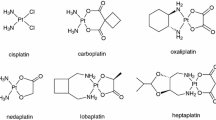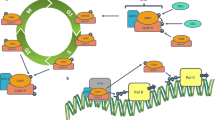Summary
Platinum (Pt)-based anticancer drugs are the mainstay of treatment for solid cancers. However, resistance to Pt drugs develops rapidly, which can be caused by overexpression of multidrug resistance transporters and activation of DNA repair. CUDC-907 is a potent molecular targeted anticancer agent, rationally designed to simultaneously inhibit histone deacetylase (HDAC) and phosphatidylinositol 3-kinase (PI3K). We investigated the potentiation effect of CUDC-907 on Pt drugs in resistant cancer cells. ABCC2 stably-transfected HEK293 cells and two pairs of parental and Pt-resistant cancer cell lines were used to test for the circumvention of resistance by CUDC-907. Chemosensitivity was assessed by the sulphorhodamine B assay. Drug combinations were evaluated by the median effect analysis. ABCC2 transport activity was examined by flow cytometric assay. Cellular Pt drug accumulation and DNA platination were detected by inductively coupled plasma optical emission spectroscopy. ABCC2, ERCC1 and p21 expression were evaluated by quantitative real-time PCR. Cell cycle analysis and apoptosis assay were performed by standard flow cytometric method. The combination of CUDC-907 with cisplatin were found to exhibit synergistic cytotoxic effect in cisplatin-resistant cancer cells. In Pt-resistant cancer cells, CUDC-907 apparently circumvented the resistance through inhibition of ABCC2 and DNA repair but induction of cell cycle arrest. In the presence of CUDC-907, cellular accumulation of Pt drugs and formation of DNA-Pt adducts were found to be increased whereas expression levels of ABCC2 and ERCC1 was inhibited in Pt-resistant cells. The data advocates further development of CUDC-907 as a resistance reversal agent for use in combination cancer chemotherapy.







Similar content being viewed by others
Abbreviations
- ABC:
-
ATP-Binding Cassette
- BB:
-
Benzbromarone
- CFDA:
-
Carboxy-2′,7′-dichlorofluorescein
- CI:
-
Combination Index
- HDAC:
-
Histone Deacetylase
- ICP-OES:
-
Inductively Coupled Plasma Optical Emission Spectrometer
- MDR:
-
Multidrug Resistance
- PI3K:
-
Phosphatidylinositol 3-kinase
- Pt:
-
Platinum
- TKI:
-
Tyrosine Kinase Inhibitor
References
Siddik ZH (2003) Cisplatin: mode of cytotoxic action and molecular basis of resistance. Oncogene 22:7265–7279
Rabik CA, Dolan ME (2007) Molecular mechanisms of resistance and toxicity associated with platinating agents. Cancer Treat Rev 33:9–23
Galluzzi L, Senovilla L, Vitale I, Michels J, Martins I, Kepp O, Castedo M, Kroemer G (2012) Molecular mechanisms of cisplatin resistance. Oncogene 31:1869–1883
Mi YJ, Liang YJ, Huang HB, Zhao HY, Wu CP, Wang F, Tao LY, Zhang CZ, Dai CL, Tiwari AK, Ma XX, To KK, Ambudkar SV, Chen ZS, Fu LW (2010) Apatinib (YN968D1) reverses multidrug resistance by inhibiting the efflux function of multiple ATP-binding cassette transporters. Cancer Res 70:7981–7991
Tong XZ, Wang F, Liang S, Zhang X, He JH, Chen XG, Liang YJ, Mi YJ, To KK, Fu LW (2012) Apatinib (YN968D1) enhances the efficacy of conventional chemotherapeutical drugs in side population cells and ABCB1-overexpressing leukemia cells. Biochem Pharmacol 83:586–597
Wang XK, He JH, Xu JH, Ye S, Wang F, Zhang H, Huang ZC, To KK, Fu LW (2014) Afatinib enhances the efficacy of conventional chemotherapeutic agents by eradicating cancer stem-like cells. Cancer Res 74:4431–4445
To KK, Poon DC, Wei Y, Wang F, Lin G, Fu L (2015) Pelitinib (EKB-569) targets the upregulation of ABCB1 and ABCG2 under hyperthermia to eradicate lung cancer. Br J Pharmacol 172:4089–4106
To KK, Poon DC, Wei Y, Wang F, Lin G, Fu LW (2015) Vatalanib sensitizes ABCB1 and ABCG2-overexpressing multidrug resistant colon cancer cells to chemotherapy under hypoxia. Biochem Pharmacol 97:27–37
Qian C, Lai CJ, Bao R, Wang DG, Wang J, Xu GX, Atoyan R, Qu H, Yin L, Samson M, Zifcak B, Ma AW, DellaRocca S, Borek M, Zhai HX, Cai X, Voi M (2012) Cancer network disruption by a single molecule inhibitor targeting both histone deacetylase activity and phosphatidylinositol 3-kinase signaling. Clin Cancer Res 18:4104–4113
Sun K, Atoyan R, Borek MA, Dellarocca S, Samson ME, Ma AW, Xu GX, Patterson T, Tuck DP, Viner JL, Fattaey A, Wang J (2017) Dual HDAC and PI3K inhibitor CUDC-907 downregulates MYC and suppresses growth of MYC-dependent cancers. Mol Cancer Ther 16:285–299
Mondello P, Derenzini E, Asgari Z, Philip J, Brea EJ, Seshan V, Hendrickson RC, de Stanchina E, Scheinberg DA, Younes A (2017) Dual inhibition of histone deacetylases and phosphoinositide 3-kinase enhances therapeutic activity against B cell lymphoma. Oncotarget 8:14017–14028
Younes A, Berdeja JG, Patel MR, Flinn I, Gerecitano JF, Neelapu SS, Kelly KR, Copeland AR, Akins A, Clancy MS, Gong L, Wang J, Ma A, Viner JL, Oki Y (2016) Safety, tolerability, and preliminary activity of CUDC-907, a first-in-class, oral, dual inhibitor of HDAC and PI3K, in patients with relapsed or refractory lymphoma or multiple myeloma: an open-label, dose-escalation, phase 1 trial. Lancet Oncol 17:622–631
To KK, Tong WS, Fu LW (2017) Reversal of platinum drug resistance by the histone deacetylase inhibitor belinostat. Lung Cancer 103:58–65
Skehan P, Stornet R, Scudiero D, Monks A, McMahon J, Vistica D, Warren JT, Bokesch H, Henney S, Boyd MR (1990) New colorimetric cytotoxicity assay for anticancer-drug screening. J Natl Cancer Inst 82:1107–1112
Chou TC (2010) Drug combination studies and their synergy quantification using the Chou-Talalay method. Cancer Res 70:440–446
Glaser KB, Staver MJ, Waring JF, Stender J, Ulrich RG, Davidsen SK (2003) Gene expression profiling of multiple histone deacetylase (HDAC) inhibitors: defining a common gene set produced by HDAC inhibition in T24 and MDA carcinoma cell lines. Mol Cancer Ther 2:151–153
Chueh AC, Tse JW, Togel L, Mariadason JM (2015) Mechanism of histone deacetylase inhibitor-regulated gene expression in cancer cells. Antioxid Redox Signal 23:66–84
Crim KC, Sanders LM, Hong MY, Taddeo SS, Tumer ND, Chaokin RS, Lupton JR (2008) Upregulation of p21Waf1/Cip1 expression in vivo by butyrate administration can be chemoprotective or chemopromotive depending on the lipid component of the diet. Carcinogenesis 29:1415–1420
Boulikas T, Vougiouka M (2004) Recent clinical trials using cisplatin, carboplatin and their combination chemotherapy drugs (review). Oncol Rep 11:559–595
Ambudkar SV (1998) Drug-stimulatable ATPase activity in crude membranes of human MDR1-transfected mammalian cells. Methods Enzymol 292:504–514
Shi Z, Peng XX, Kim IW, Shukla S, Si QS, Robey RW, Bates SE, Shen T, Ashby CR Jr, Fu LW, Ambudkar SV, Chen ZS (2007) Erlotinib (Tarceva, OSI-774) antagonizes ATP-binding cassette subfamily B member 1 and ATP-binding cassette subfamily G member 2-mediated drug resistance. Cancer Res 67:11012–11020
Dai CL, Tiwari AK, Wu CP, Su XD, Wang XR, Liu DG, Ashby CR Jr, Huang Y, Robey RW, Liang YJ, Chen LM, Shi CJ, Ambudkar SV, Chen ZS, Fu LW (2008) Lapatinib (Tykerb, GW572016) reverses multidrug resistance in cancer cells by inhibiting the activity of ATP-binding cassette subfamily B member 1 and G member 2. Cancer Res 68:7905–7914
Wu CP, Hsieh YJ, Hsiao SH, Su CY, Li YQ, Huang YH, Huang CW, Hsieh CH, Yu JS, Wu YS (2016) Human ATP-binding cassette transporter ABCG2 confers resistance to CUDC-907, a dual inhibitor of histone deacetylase and phosphatidylinositol 3-kinase. Mol Pharm 13:784–794
Minucci S, Pelicci P (2006) Histone deacetylase inhibitors and the promise of epigenetic (and more) treatments for cancer. Nat Rev Cancer 6:38–51
Surowial P, Materna V, Kaplenko I, Spacznski M, Dolinska-Krajewska B, Gebarowska E, Dietel M, Zabel M, Lage H (2006) ABCC2 (MRP2, cMOAT) can be localized in the nuclear membrane of ovarian carcinomas and correlates with resistance to cisplatin and clinical outcome. Clin Cancer Res 12:7149–7158
Yamasaki M, Makino T, Masuzawa T, Kurokawa Y, Miyata H, Takiguchi S, Nakajima K, Fujiwara Y, Matsuura N, Mori M, Doki Y (2011) Role of multidrug resistance protein 2 (MRP2) in chemoresistance and clinical outcome in oesophageal squamous cell carcinoma. Br J Cancer 104:707–713
Kim H, Kim SN, Park YS, Kim NH, Han JW, Lee HY, Kim YK (2011) HDAC inhibitors downregulate MRP2 expression in multidrug resistant cancer cells: implication for chemosensitization. Int J Oncol 38:807–812
Cai Y, Yan X, Zhang G, Zhao W, Jiao S (2015) The predictive value of ERCC1 and p53 for the effect of panobinostat and cisplatin combination treatment in NSCLC. Oncotarget 6:18997–19005
Younes A, Flinn IW, Oki Y, Copland A, Fattaey A, Lai CJ, Laliberte R, Voi M, Berdeja JG (2013) A first-in-man phase I study of CUDC-907, a first-in-class chemically-designed dual inhibitor of PI3K and HDAC in patients with refractory or relapsed lymphoma and multiple myeloma. American society of Hematology annual meeting 2013, New Orleans, Dec 7-10, 2013, poster # 4363
Acknowledgements
We would like to thank Dr. Michael Gottesman (National Cancer Institute, NIH), Dr. Susan Bates (National Cancer Institute, NIH), and Prof. Cho Chi Hin (School of Biomedical Sciences, The Chinese University of Hong Kong) for the cell lines employed in the study.
Funding
The work was supported by the NSFC/RGC Joint Research Scheme 2010/11 sponsored by the Research Grants Council of Hong Kong and the National Natural Science Foundation of China (Project No. N_CUHK443/10) and the CUHK Direct Grant for Research (4054296).
Author information
Authors and Affiliations
Corresponding author
Ethics declarations
Conflict of interest
All authors declare that they have no conflict of interest.
Ethical approval
This article does not contain any studies with human participants or animals performed by any of the authors.
Informed consent
For this type of study, informed consent is not required.
Electronic supplementary material
Supplementary Fig. 1
CUDC-907 sensitized cisplatin-resistant HKESC-1 cisR cells to apoptosis. (A) Cells were exposed to cisplatin alone (5 μM), CUDC-907 alone (20 nM), or their combination for 48 h before harvest for apoptosis assay. A representative set of data from three independent experiments is shown. (B) Summary of apoptosis assay data in (A) from three independent experiments. Data are presented in histogram as means ± SD. (TIFF 157 kb)
Supplementary Fig. 2
CUDC-907 increased cellular accumulation of cisplatin in cisplatin-resistant HKESC-1 cisR cells by downregulating ABCC2 expression. (Top panel) Cisplatin accumulation in CUDC-907-treated HKESC-1 and HKESC-1 cisR cells. There was a remarkable reduction in cisplatin accumulation in HKESC-1 cisR cells, relative to the parental HKESC-1 cells. (Bottom panel) Quantitative real-time PCR analysis of ABCC2 mRNA expression in CUDC-907 treated HKESC-1 and HKESC-1 cisR cells. The value in HKESC-1 cells without CUDC-907 treatment was set as 1 for comparison. The mean value from three independent experiments is shown. * p < 0.05, ** p < 0.01, compared with untreated HKESC-1 cisR cells. (TIFF 81 kb)
Supplementary Fig. 3
CUDC-907 increased DNA platination in cisplatin-treated HKESC-1 cisR cells by downregulating ERCC1 expression. (Top panel) DNA platination in HKESC-1 and HKESC-1 cisR cells treated with combination of cisplatin (100 μM) and different concentrations of CUDC-907. There was a significant decrease in DNA platination in cisplatin-resistant HKESC-1 cisR cells, relative to the parental HKESC-1 cells. (Bottom panel) Quantitative real-time PCR analysis of ERCC1 expression in CUDC-907-treated HKESC-1 and HKESC-1 cisR cells. The value in HKESC-1 without CUDC-907 treatment was set as 1 for comparison. The mean value from three independent experiments is shown. * p < 0.05, ** p < 0.01, compared with untreated HKESC-1 cisR cells. (TIFF 80 kb)
Supplementary Fig. 4
Cell cycle analysis in parental HKESC-1 and cisplatin-resistant HKESC-1 cisR cells after cisplatin or CUDC-907 alone or their combination. Summary of cell cycle analysis results from three independent experiments. Data are presented in histograms as mean ± SD; * p < 0.01, versus no treatment in cisplatin-resistant HKESC-1 cisR cells. (TIFF 72 kb)
Rights and permissions
About this article
Cite this article
To, K.K.W., Fu, Lw. CUDC-907, a dual HDAC and PI3K inhibitor, reverses platinum drug resistance. Invest New Drugs 36, 10–19 (2018). https://doi.org/10.1007/s10637-017-0501-9
Received:
Accepted:
Published:
Issue Date:
DOI: https://doi.org/10.1007/s10637-017-0501-9




